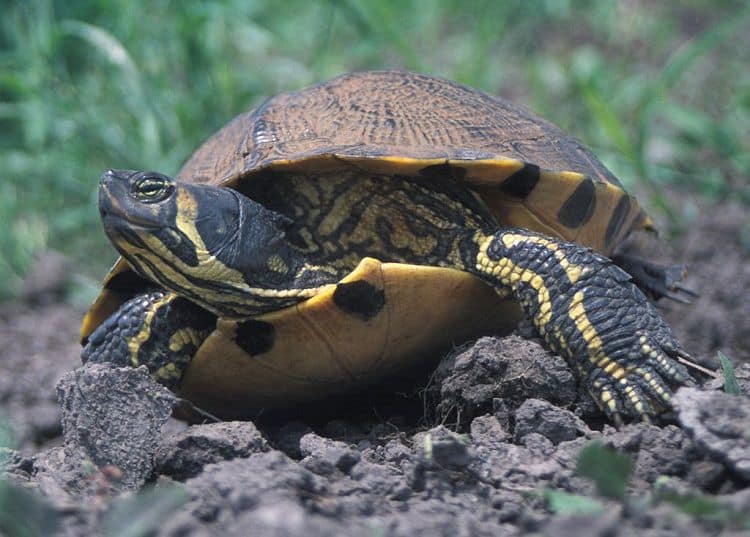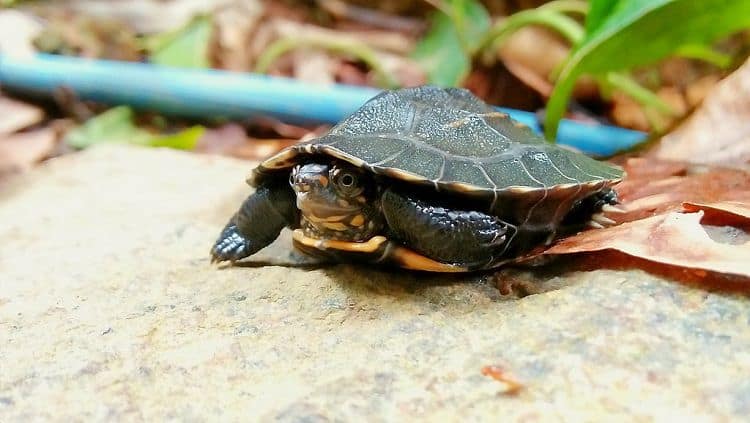Table of Contents
One of the more frequently asked questions relating to terrapins is the following: do terrapins shed shell. Indeed, some individuals even want to know if these reptiles can leave their shells. What surprises many is the fact that terrapins are fully attached to their shells and cannot leave them. In fact, a terrapin’s shell grows right along with its body.
In terms of shedding their shell, terrapins do not lose their shell and grow a new one in the same way that some other reptiles, like snakes and lizards, shed their skin. Terrapins
and lizards, shed their skin. Terrapins do, however, go through periods where their shell will peel.
do, however, go through periods where their shell will peel.
Why is My Terrapin Shedding?
A terrapin’s shell is made mostly of bone, with the average shell containing around sixty bones. Most people are not aware of this though because these shells do not actually look like bone. Terrapin shells are covered in plates called scutes, which are made from keratin. This is the same substance found in human nails. Scutes often fall off as terrapins grow, a process known as shedding or peeling.
As a terrapin grows, new, larger scutes form beneath the old ones, which then allows the shell to expand. It is both natural and normal then for scutes to fall off a terrapin so there is no need to panic if you notice this happening to yours. Nevertheless, natural shedding is not the only reason a terrapin’s shell might start to peel. As some peeling or shedding can be a sign of a health problem, it is important to be aware of the reasons this can happen. Either way, if you are worried about your terrapin’s shedding, it is probably best to contact a vet for advice.

Yellow-Bellied Slider 
Diamondback Terrapin 
Red-Eared Slider
What is Normal Shedding?
Normal, healthy shedding of scutes usually means the entire scute will come off intact and not in small pieces. You should see thin layers being shed with a normal, healthy looking shell underneath.
Terrapins can suffer from dysecdysis, which is the term used for abnormal shedding. This can be caused by certain issues that can include bone disease, or problems with the liver, thyroid, or kidney. It can also be the result of poor nutrition. There are other reasons for abnormal shedding, including injury to the shell from sharp rocks or other items in the enclosure, a basking area that is too hot, or overfeeding resulting in rapid growth.
Why is My Terrapin’s Shell Soft?
A terrapin’s shell should be hard without any soft spots. A soft shell in a terrapin may be a sign of metabolic bone disease (MBD), which is a major cause of death. It is typically caused by insufficient lighting and a poor diet.
It is vital that terrapins get sufficient amounts of calcium to thrive. These creatures require calcium in their bloodstream and without the right amounts, this calcium will be taken from the bones, particularly the shell. If this is allowed to continue, the shell will become weakened and soft. This is why it is so important to have the right setup when taking care of terrapins. In a nutshell, MBD is most commonly caused by poor husbandry issues.

You will also need to ensure that the temperature of the tank is at the correct level. Terrapins require both land and water and will need an area on which they can bask. Water temperature should be between 75F and 80F with the overall tank temperature sitting between 77F and 86F. Enclosure temperatures can be achieved with an appropriate UV heat lamp. If you’re interested, Amazon has a great selection here
and will need an area on which they can bask. Water temperature should be between 75F and 80F with the overall tank temperature sitting between 77F and 86F. Enclosure temperatures can be achieved with an appropriate UV heat lamp. If you’re interested, Amazon has a great selection here (opens in a new tab).
(opens in a new tab).
A terrapin tank will require regular cleaning as well as the water can get very dirty. Terrapins eat and poop in the water , so even with a powerful filter, regular water changing is a must.
, so even with a powerful filter, regular water changing is a must.
To be healthy, a terrapin will also need a balanced, varied diet. As omnivores, terrapins eat both plants and animals, so food choices are plentiful. However, it is your responsibility to ensure that in addition to the right foods, your terrapin gets the correct vitamins and minerals. You can buy supplements in a local pet store or online (here are some at Amazon ). By providing a healthy diet with the correct vitamins and minerals, your terrapin will thrive and should not have issues with abnormal shell shedding.
). By providing a healthy diet with the correct vitamins and minerals, your terrapin will thrive and should not have issues with abnormal shell shedding.
Photo Credits:
- Featured Image (Indian Pond Terrapin): Rasikamt – CC BY-SA 4.0

- Diamondback Terrapin: Ryan Hagerty – public domain
- Yellow-Bellied Slider: John J. Mosesso, NBII – public domain
- Smiling Terrapin: Wibowo Djatmiko (Wie146
 ) – CC BY-SA 3.0
) – CC BY-SA 3.0
- Red-Eared Slider: Monika Korzeniec
 – CC BY-SA 3.0
– CC BY-SA 3.0
Video: didimitten

